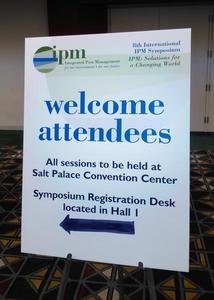Europe
May 5, 2015
 A team of six ENDURE scientists presented ongoing IPM activities in Europe at the 8th International Integrated Pest Management (IPM) Symposium held in Salt Lake City, USA, from March 23 to 26. The team comprised Graham Begg and Nick Birch from the UK's The James Hutton Institute (JHI), Jay Ram Lamichhane from France's National Institute for Agricultural Research (INRA), Maurizio Sattin and Vasileios Vasileiadis from Italy's National Research Council (CNR), and Per Kudsk from Denmark's Aarhus University (AU).
A team of six ENDURE scientists presented ongoing IPM activities in Europe at the 8th International Integrated Pest Management (IPM) Symposium held in Salt Lake City, USA, from March 23 to 26. The team comprised Graham Begg and Nick Birch from the UK's The James Hutton Institute (JHI), Jay Ram Lamichhane from France's National Institute for Agricultural Research (INRA), Maurizio Sattin and Vasileios Vasileiadis from Italy's National Research Council (CNR), and Per Kudsk from Denmark's Aarhus University (AU).
Graham Begg gave a presentation on landscape scale and area-wide IPM in Europe as part of a pre-conference session on 'Novel Applications of Geo-Technologies in Agriculture and Non-Agriculture IPM Decision Support'. Using examples from across Europe, Graham set out the current status spatial or area-wide IPM strategies in Europe and established that most spatial and geo-tech approaches were reactive, used to forecast pest risk under current control strategies.
The presentation went on to stress the importance of proactive modelling approaches that can be used to predict pest risk under alternative 'geo-IPM' strategies with examples taken from PURE and ENDURE. The hour-long presentation concluded with a demonstration of the AgBioscape modelling software developed in PURE, exploring the success of alternative crop rotation strategies to achieve area-wide control of Diabrotica virgifera virgifera (western corn rootworm).

Maurizio Sattin, Vasileios Vasileiadis and Per Kudsk (pictured) organised a session entitled 'IPM in arable cropping systems: Lessons learnt from a European project'. The objective of the session was to present and discuss the results of work packages two and three of the PURE project. Per Kudsk (pictured right) very briefly presented the PURE project before giving his talk on 'Agronomic evaluation of IPM strategies in European winter wheat production' in which he presented the results of six multi-year on-station experiments conducted in five European countries to evaluate two IPM strategies (IPM1 and IPM2) against current practice (CUR).
Overall, weeds, diseases and pests were effectively controlled with CUR and IPM1 while unsatisfactory control was observed with IPM2 in some years and in some locations. IPM1 winter wheat yields were comparable to or in some cases lower than with CUR, while yields with IPM2 were generally lower. Pesticide use was significantly reduced with both IPM1 and IPM2 compared to CUR. Several IPM tools were very effective and could, if implemented more widely, reduce the reliance on pesticides.
Maurizio Sattin gave a talk on 'Agronomic evaluation of IPM strategies in European maize production'. Within the PURE project, on-farm trials were set up in five European countries to evaluate IPM tools against weeds and European corn borer (ECB) in grain maize, compared to conventional management (CON). On-station experiments were also conducted in three countries to evaluate two IPM levels against CON in maize-based rotations. Overall, IPM tools tested on-farm provided sufficient weed control, without differences in ECB plant damage and maize yields compared to CON, whereas in on-station experiments IPM1 and CON performed similarly. Weed infestation and yield in IPM2 were higher and lower than in CON, respectively.
Vasileios Vasileiadis presented 'Economic and environmental evaluation of IPM strategies in wheat- and maize-based rotations'. Within the PURE project, long-term on-station experiments were conducted to evaluate wheat and maize-based rotations with different IPM levels against the conventional cropping system. IPM strategies aimed to reduce pesticide use or achieve a sustainable use of pesticides (for example, band application of herbicides, mechanical weeding, bio-insecticides). The ex-post assessment of their sustainability was conducted using an adapted version of the DEXiPM model and, overall, IPM systems were found to have lower environmental impacts, whereas their economic sustainability depended on changes in the costs of IPM tools, possible yield reductions and type of crops in the rotation compared to conventional systems.

Jay Ram Lamichhane and Nick Birch (pictured right) gave their presentation in a session entitled 'Does collaboration make IPM work? Stories from OECD countries, Europe and Canada'. The objective of the session was to present and discuss the importance of trans-national networking to advance IPM.
Jay Ram Lamichhane presented ongoing IPM networking activities in Europe, their importance, the challenges related to IPM R&D and implementation issues, as well as the approaches that are considered to overcome these challenges through transnational collaboration in Europe. He reminded participants how the ENDURE European Network of Excellence, established almost a decade ago, successfully linked European institutions committed to IPM research and implementation. Many subsequent European IPM projects such as PURE, build upon the outcomes and lessons learned from ENDURE and the latter paved the way for C-IPM, a recently established network among 21 European countries aiming to create added value and synergies by coordinating national IPM research and extension capabilities.
Nick Birch presented his work entitled 'From research to practice: European berry fruit and field vegetables IPM'. Several European Union (EU) projects (for example, PURE) are developing IPM for cropping systems starting with innovative tools and demonstrating best combinations of the 'IPM toolbox' under on-station and on-farm conditions. The approach is collaborative across research disciplines (for example, plant breeding and genetics, chemical ecology, behavioural ecology, modelling, agronomy) and among EU partners, involving researcher-farmer-policy maker 'co-innovation' from the start. Nick illustrated this work with an example of a raspberry IPM system using pest-resistant varieties, biocontrol, biopesticides and biomimicry-based trapping/monitoring. A second example, based on IPM for brassica vegetables from PURE, illustrated how chemical ecology could lead to future IPM strategies for a key pest, cabbage root fly.
For more information:
- Per Kudsk, Caroline Colnenne-David, Silke Dachbrodt-Saaydeh, Roman Kierzek, Bo Melander, Adrien Newton, Lise Nistrup Jørgensen, Clotilde Toque (2015). Agronomic evaluation of IPM strategies in European winter-wheat production. Proceedings of the 8th International Integrated Pest Management Symposium, p. 26.
- Maurizio Sattin, Gregor Urek, Robert Leskovšek, Jaka Razinger, Lorenzo Furlan, Arnd Verschwele, Imre J. Holb, Marion Giraud, Florence Leprince, Nathalie Verjux, Gilles Espagnol, Vasileios P. Vasileiadis (2015). Agronomic evaluation of IPM strategies in European maize production. Proceedings of the 8th International Integrated Pest Management Symposium, p. 26.
- Vasileios Vasileiadis, Wim van Dijk, Lorenzo Furlan, Imre J. Holb, Florence Leprince, Maurizio Sattin, Silke Dachbrodt-Saaydeh, Per Kudsk, Maud Benezit, Caroline Colnenne-David, Roman Kierzek, Marianne Lefebvre, Adrian Newton, Clotilde Toque (2015). Economic and environmental evaluation of IPM strategies in wheat- and maize-based rotations. Proceedings of the 8th International Integrated Pest Management Symposium, p. 26.
- Jay Ram Lamichhane, Silke Dachbrodt-Saaydeh, Per Kudsk and Antoine Messéan (2015). From ENDURE to C-IPM: The power of networking to advance IPM implementation in Europe. Proceedings of the 8th International Integrated Pest Management Symposium, p. 41.
- Nick Birch, Begg Graham and Deasy William (2015). From research to practice: European berry fruit and field vegetables IPM. Proceedings of the 8th International Integrated Pest Management Symposium, p. 41.
- Visit the 8th International IPM Symposium website
- Download the proceedings: IPM_2015_Proceedings-final